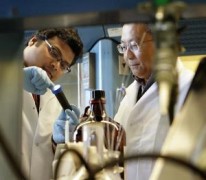Maui Brown chemists have succeeded in preparing a unique nanoparticle core and shell system that uses much less platinum and still works efficiently and continuously

In a new study, Brown University chemists report promising progress in this area. They were able to prepare a unique nanoparticle core and shell system that utilizes much less platinum and still works more efficiently and sustainably than commercially available platinum-only catalysts.
The chemistry at the heart of the fuel cell, known as the redox reaction of oxygen, and which occurs at the cathode of the cell, produces water as the only "waste" material and not the greenhouse gas carbon dioxide, which is created in internal combustion systems.
The cathode is also responsible for the loss of the cell's efficiency, up to forty percent of it, so "this is an essential step in the preparation of fuel cells that are more competitive than internal combustion engines and batteries," said researcher Shouheng Sun, professor of chemistry at Brown University and one of the authors of the paper describing the research. , an article published in the scientific journal Journal of the American Chemical Society.
The research team prepared a palladium core with a size of five nanometers and surrounded it with a shell consisting of iron and platinum (FePt). The trick, the researcher explains, was to design a shell that would preserve its structure and also require the least possible amount of platinum to obtain a desired chemical reaction. The team prepared the iron-platinum shell by decomposing iron-pentacarbonyl[Fe(CO)5] and reducing platinum-acetylacetone [Pt(acac)2], a method reported by the lead researcher in 2000 in the journal Science. The result was a shell that uses only thirty percent of the initial amount of platinum, although the researchers say they anticipate being able to make even thinner shells that use less platinum.
The researchers demonstrated for the first time ever that they are able to consistently prepare unique core-shell structures. In laboratory experiments, the nanoparticles of the palladium/iron-platinum system produced a current 12 times greater than that obtained in systems using commercial catalysts composed only of platinum for the same catalyst weight.
Output also remains consistent after 10,000 cycles, at least ten times more than commercially available platinum systems that begin to lose their desired activity after only 1000 cycles. The researchers made iron-platinum shells that ranged in size from one to three nanometers. In laboratory experiments, the researchers found that envelopes with a size of one nanometer work best.
"This is a very good demonstration, that catalysts consisting of a core and a shell can be easily prepared in quantities of half a gram in the laboratory, that they are active and that they are durable over time," notes the researcher. "The next step is to produce them on a commercial scale and we are convinced that we can do that."
The researchers are trying to understand why the palladium core manages to increase the catalytic capabilities of the iron-platinum shell, and they currently believe it has to do with the transfer of electrons between the core and shell metals. They are currently trying to use metals that are more chemically active than palladium as the core of the system to verify that the transfer of electrons between the core and the shell is indeed the factor that affects the functioning of the catalyst.

3 תגובות
There is an Israeli company that has developed a fuel cell that does not need platinum at all!!
It is located in Caesarea if I am not mistaken. Can't remember her name
A vehicle running on a fuel cell currently costs about a million dollars, by what percentage will a vehicle running on the new method of fuel cell be cheaper?
You also need luck…